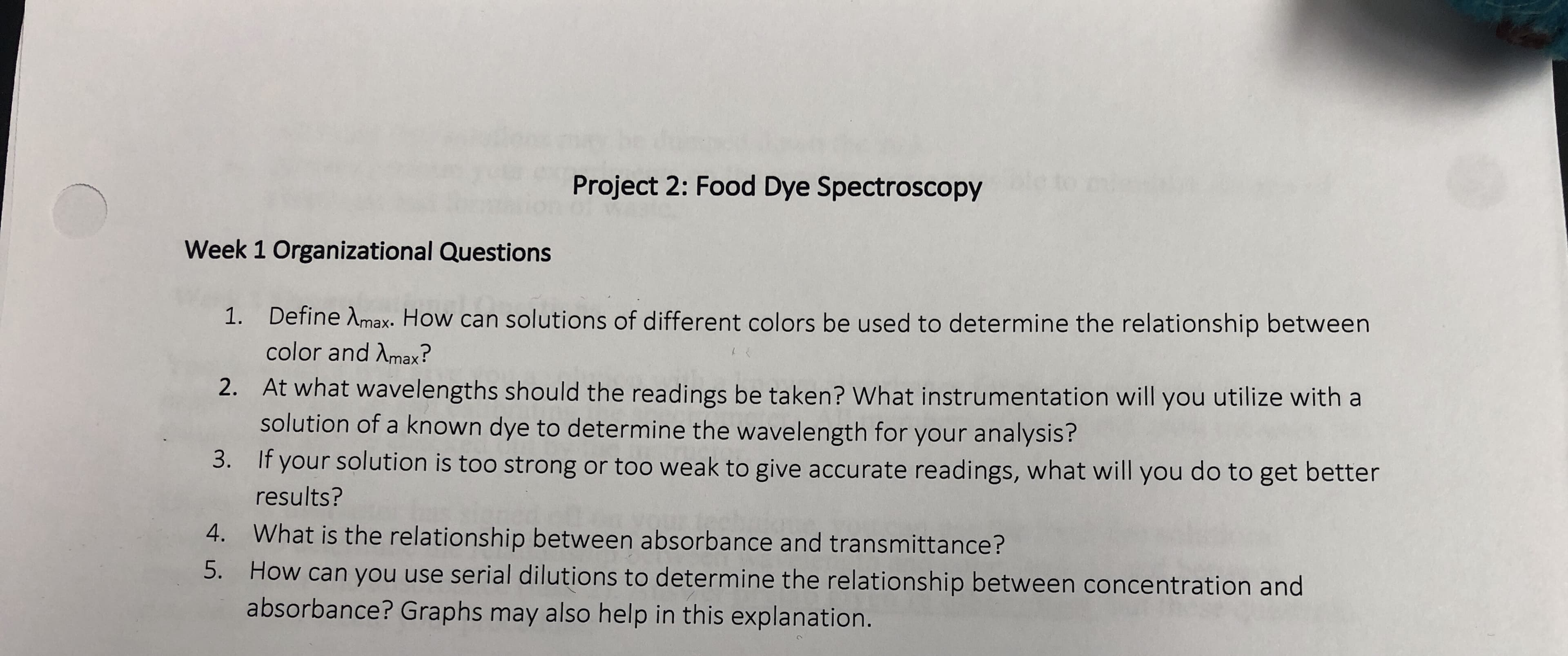Project 2: Food Dye Spectroscopy Week 1 Organizational Questions Define λmax-How can solutions of different colors be used to determine the relationship between color and Amax? 1. At what wavelengths should the readings be taken? What instrumentation will you utilize with a solution of a known dye to determine the wavelength for your analysis? If your solution is too strong or too weak to give accurate readings, what will you do to get better 2. 3. results? 4. What is the relationship between absorbance and transmittance? 5. How can you use serial dilutions to determine the relationship between concentration and absorbance? Graphs may also help in this explanation.
Project 2: Food Dye Spectroscopy Week 1 Organizational Questions Define λmax-How can solutions of different colors be used to determine the relationship between color and Amax? 1. At what wavelengths should the readings be taken? What instrumentation will you utilize with a solution of a known dye to determine the wavelength for your analysis? If your solution is too strong or too weak to give accurate readings, what will you do to get better 2. 3. results? 4. What is the relationship between absorbance and transmittance? 5. How can you use serial dilutions to determine the relationship between concentration and absorbance? Graphs may also help in this explanation.
ChapterU5: Fire: Energy , Thermodynamics, And Oxidation-reduction
SectionU5.116: How Absorbing: Spectroscopy
Problem 6E
Related questions
Question
100%
Please answer all and post below the answer the source from where you got the answer
thank you!

Transcribed Image Text:Project 2: Food Dye Spectroscopy
Week 1 Organizational Questions
Define λmax-How can solutions of different colors be used to determine the relationship between
color and Amax?
1.
At what wavelengths should the readings be taken? What instrumentation will you utilize with a
solution of a known dye to determine the wavelength for your analysis?
If your solution is too strong or too weak to give accurate readings, what will you do to get better
2.
3.
results?
4. What is the relationship between absorbance and transmittance?
5. How can you use serial dilutions to determine the relationship between concentration and
absorbance? Graphs may also help in this explanation.
Expert Solution
This question has been solved!
Explore an expertly crafted, step-by-step solution for a thorough understanding of key concepts.
This is a popular solution!
Trending now
This is a popular solution!
Step by step
Solved in 5 steps with 1 images

Knowledge Booster
Learn more about
Need a deep-dive on the concept behind this application? Look no further. Learn more about this topic, chemistry and related others by exploring similar questions and additional content below.Recommended textbooks for you



Chemistry & Chemical Reactivity
Chemistry
ISBN:
9781337399074
Author:
John C. Kotz, Paul M. Treichel, John Townsend, David Treichel
Publisher:
Cengage Learning



Chemistry & Chemical Reactivity
Chemistry
ISBN:
9781337399074
Author:
John C. Kotz, Paul M. Treichel, John Townsend, David Treichel
Publisher:
Cengage Learning

Chemistry & Chemical Reactivity
Chemistry
ISBN:
9781133949640
Author:
John C. Kotz, Paul M. Treichel, John Townsend, David Treichel
Publisher:
Cengage Learning

Principles of Instrumental Analysis
Chemistry
ISBN:
9781305577213
Author:
Douglas A. Skoog, F. James Holler, Stanley R. Crouch
Publisher:
Cengage Learning

Macroscale and Microscale Organic Experiments
Chemistry
ISBN:
9781305577190
Author:
Kenneth L. Williamson, Katherine M. Masters
Publisher:
Brooks Cole